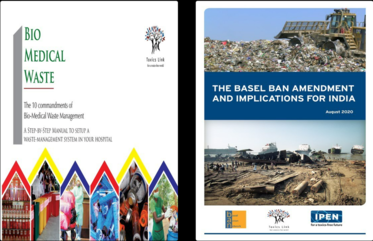Impact of climate change
GOVERNMENT OF INDIA
MINISTRY OF ENVIRONMENT, FOREST AND CLIMATE CHANGE
RAJYA SABHA
UNSTARRED QUESTION NO. 1023
TO BE ANSWERED ON 13.02.2025
Impact of climate change
1023. DR. KANIMOZHI NVN SOMU: SHRI R. GIRIRAJAN:
Will the Minister of ENVIRONMENT, FOREST AND CLIMATE CHANGE be pleased to state:
(a) whether Government is aware of the serious consequences and impacts of climate change in the country and if so, the details thereof, if not, the reasons therefor; (b) whether Government has taken adequate steps to control carbon emissions and environmental degradation due to multiple factors and if so, the details thereof; and (c) the funds allocated to various States in the last five years to protect ecology and environment and to control environmental degradation, State-wise, year-wise?
ANSWER
MINISTER OF STATE IN THE MINISTRY OF ENVIRONMENT, FOREST AND CLIMATE CHANGE
(SHRI KIRTI VARDHAN SINGH)
(a) to (c) As per Climate Change 2022: Impacts, Adaptation and Vulnerability-Contribution of Working Group II to the Sixth Assessment Report of the Intergovernmental Panel on Climate Change (IPCC); Global warming, reaching 1.5°C in the near-term, would cause unavoidable increases in multiple climate hazards and present multiple risks to ecosystems and humans. The level of risk will depend on concurrent near-term trends in vulnerability, exposure, level of socioeconomic development and adaptation. Near-term actions that limit global warming to close to 1.5°C would substantially reduce projected losses and damages related to climate change in human systems and ecosystems, compared to higher warming levels, but cannot eliminate them all.
As per the Third National Communication submitted by India to the United Nations Framework convention on the Climate Change (UNFCCC) in December 2023, India is experiencing full range of climate change impacts, ranging from floods and droughts to heat waves and glacier melt. The Government is seized of the matter and has taken number of steps to reduce the vulnerability and mitigate the impacts of the climate change. India is an emerging economy where Greenhouse Gas emissions are set to increase, in pursuit of its development and poverty eradication goals. India’s historical cumulative emissions from 1850 to 2019 amount to less than 4 percent of cumulative carbon dioxide emissions of the world, despite being home to 18 per cent of the world’s population. Hence, India’s contribution to global warming is minimal and even current annual per capita emissions are only about one-third of the global average. Nevertheless, India is committed to combating climate change by making development choices that ensure the growth and development of the economy along low-carbon pathways toward net zero by 2070. India is addressing the challenge with firm adherence to multilateralism based on equity and the principle of common but differentiated responsibilities and respective capabilities (CBDR-RC), as enshrined in the United Nations Framework Convention on Climate Change (UNFCCC).
The Government of India stands committed to combating climate change through its several programmes and schemes including the National Action Plan on Climate Change (NAPCC) which comprises nine missions in specific areas of solar energy, energy efficiency, water, sustainable agriculture, Himalayan ecosystem, sustainable habitat, health, green India, and strategic knowledge for climate change. The NAPCC provides an overarching framework for all climate actions. All these Missions focus on strategies to combat the adverse impacts of climate change, and, are institutionalized and implemented by the respective Nodal Ministries/Departments. Further, thirty-four States and Union Territories (UTs) have prepared their respective State Action Plans on Climate Change (SAPCCs).
The SAPCCs are designed to be context specific, and inter-alia, provide adaptation strategies considering each State’s different ecological, social, and economic conditions. The National Adaptation Fund for Climate Change (NAFCC) supports adaptation activities in the States and UTs that are vulnerable to the adverse effects of climate change. Under NAFCC, 30 projects have been sanctioned in 27 States and UTs with total project cost of Rs 847.48 crores. In August 2022, India updated its Nationally Determined Contribution (NDC) demonstrating higher ambition in its climate action, as agreed under the Paris Agreement. India stands committed to reduce emissions intensity of its GDP by 45 percent by 2030, from 2005 level; achieve about 50 percent cumulative electric power installed capacity from non-fossil fuel-based energy resources by 2030 which would require transfer of technology and low-cost international finance including from Green Climate Fund. India has progressively continued decoupling economic growth from GHG emissions. Between 2005 and 2020, India’s gross domestic product (GDP) emission intensity reduced by 36%. It also reaffirms India’s commitment to make a fair and equitable contribution to the global effort to mitigate climate change. Moreover, as of December 2024, the share of non-fossil fuel-based power generation capacity in the country is already over 47%. India’s forest and tree cover has consistently increased and currently stands at 25.17% of the total geographical area of the country. During 2005 to 2021, additional carbon sink of 2.29 billion tonnes of CO2 equivalent has been created. In addition, India’s Long Term Low-Carbon Development Strategy (LT-LEDS) submitted to the UNFCCC in November, 2022, provides a framework involving seven key strategic transitions for achieving net-zero emissions by 2070, based on the principles of common but differentiated responsibilities and respective capabilities, equity, and climate justice. These include
i) low-carbon development of electricity systems consistent with development,
ii) develop an integrated, efficient and inclusive transport system,
iii) promote adaptation in urban design, energy and material efficiency in buildings, and sustainable urbanisation,
iv) promoting economy-wide decoupling of growth from emissions and development of an efficient, innovative low emission industrial system,
v) development of carbon dioxide removal and related engineering solutions,
vi) enhancing forest and vegetation cover consistent with socio-economic and ecological considerations and
vii) economic and financial needs of low-carbon development. Central Government through various programmes and schemes anchored by relevant Ministries/ Departments aims to protect ecology and control environmental degradation. The Ministry of Environment, Forest and Climate Change (MoEFCC) supplements the efforts through various activities/schemes, which inter alia include National Mission for a Green India (GIM), Integrated Development of Wildlife Habitats, Compensatory Afforestation Fund Management and Planning Authority (CAMPA), Nagar Van Yojana (NVY), Mangrove Initiative for Shoreline Habitats & Tangible Incomes (MISHTI), and National Clean Air Programme (NCAP) etc.
These programmes support the efforts of the States and UTs for ecological restoration through afforestation in and outside forest areas, forest landscape restoration, habitat improvement, soil and water conservation measures, and protection etc. The details of funds provided by the MoEFCC to States and UTs during the last five years and current year under the Green India Mission, Development of Wildlife Habitats, CAMPA, Nagar Van Yojana, MISHTI, and NCAP are given at Annexure-I to Annexure-VI, respectively.






